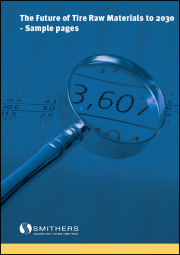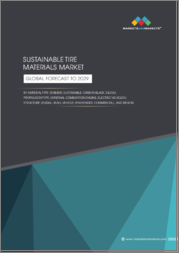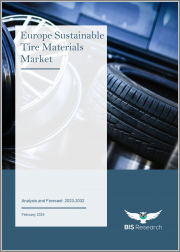
|
시장보고서
상품코드
1737017
세계의 타이어 재료 시장 규모, 점유율, 성장 분석, 차량 유형별, 유형별, 재료 유형별, 타이어 유형별, 지역별 - 산업 예측(2025-2032년)Tire Material Market Size, Share, and Growth Analysis, By Vehicle Type (Passenger Cars, Buses), By Type (Elastomers, Reinforcing Fillers), By Material Type, By Tire Type, By Region - Industry Forecast 2025-2032 |
||||||
타이어 재료 세계 시장 규모는 2023년 846억 3,000만 달러, 2024년 892억 8,000만 달러에서 2032년까지는 1,370억 2,000만 달러로 성장할 것으로 예측되며, 예측 기간(2025-2032년) CAGR은 5.5%를 나타낼 전망입니다.
세계 타이어 재료 시장은 지속가능한 모빌리티에 대한 관심과 함께 자동차 생산 증가, 전기차 및 하이브리드 자동차에 대한 수요 급증에 힘입어 지속적으로 성장하고 있습니다. 업계 혁신가들은 진화하는 성능, 안전성, 환경 인식 기준에 대응하기 위해 고내구성 합성고무, 바이오 폴리머, 친환경 필러와 같은 첨단 소재를 개발하고 있습니다. 신흥국의 도시화와 산업화는 승용차 타이어와 상용차 타이어에 대한 수요를 증가시키고 있으며, 이에 따라 프리미엄 소재에 대한 요구가 증가하고 있습니다. 또한, 스마트 타이어 기술 및 재활용에 대한 노력과 같은 트렌드는 경쟁 환경을 변화시키고 지속가능한 혁신에 대한 투자를 촉진하고 있습니다. 원자재 가격 변동과 엄격한 규제에도 불구하고, 차세대 모빌리티와 그린 테크놀로지 분야에서 비즈니스 기회가 확대되고 있어 시장 전망은 낙관적입니다.
목차
서론
- 조사 목적
- 조사 범위
- 정의
조사 방법
- 정보 조달
- 2차와 1차 데이터 방법
- 시장 규모 예측
- 시장 전제조건과 제한
주요 요약
- 세계 시장 전망
- 공급과 수요 동향 분석
- 부문별 기회 분석
시장 역학과 전망
- 시장 개요
- 시장 규모
- 시장 역학
- 성장 촉진요인과 기회
- 성장 억제요인과 과제
- Porter의 Five Forces 분석
주요 시장 인사이트
- 주요 성공 요인
- 경쟁 정도
- 주요 투자 기회
- 시장 생태계
- 시장의 매력 지수(2024년)
- PESTEL 분석
- 거시경제 지표
- 밸류체인 분석
- 가격 분석
타이어 재료 시장 규모 : 차량 유형별·CAGR(2025년-2032년)
- 시장 개요
- 승용차
- 버스
- 트럭
- 소형 상용차
타이어 재료 시장 규모 : 유형별·CAGR(2025년-2032년)
- 시장 개요
- 엘라스토머
- 강화 충전제
- 가소제
- 화학제품
- 금속 보강재
- 섬유 보강재
타이어 재료 시장 규모 : 재료 유형별·CAGR(2025년-2032년)
- 시장 개요
- 천연고무
- 합성고무
- 필러
- 가소제
- 화학제품
- 건설 및 보강재
- 기타
타이어 재료 시장 규모 : 타이어 유형별·CAGR(2025년-2032년)
- 시장 개요
- Solid Tires
- Pneumatic Tires
- Retreaded
타이어 재료 시장 규모·CAGR(2025년-2032년)
- 북미
- 미국
- 캐나다
- 유럽
- 독일
- 스페인
- 프랑스
- 영국
- 이탈리아
- 기타 유럽
- 아시아태평양
- 중국
- 인도
- 일본
- 한국
- 기타 아시아태평양
- 라틴아메리카
- 브라질
- 기타 라틴아메리카
- 중동 및 아프리카
- GCC 국가
- 남아프리카
- 기타 중동 및 아프리카
경쟁 정보
- 주요 5개사 비교
- 주요 기업의 시장 포지셔닝(2024년)
- 주요 시장 기업이 채택한 전략
- 최근 시장 동향
- 기업의 시장 점유율 분석(2024년)
- 주요 기업 개요
- 기업 상세
- 제품 포트폴리오 분석
- 기업 부문별 점유율 분석
- 매출 전년대비 비교(2022년-2024년)
주요 기업 개요
- Bridgestone Corporation(Japan)
- Michelin(France)
- Continental AG(Germany)
- Pirelli & C. S.p.A.(Italy)
- The Goodyear Tire & Rubber Company(USA)
- Sumitomo Rubber Industries, Ltd.(Japan)
- The Yokohama Rubber Company, Ltd.(Japan)
- Hankook Tire & Technology Co., Ltd.(South Korea)
- Toyo Tire Corporation(Japan)
- Nokian Tyres plc(Finland)
- Apollo Tyres Ltd.(India)
- MRF Ltd.(India)
- Balkrishna Industries Ltd.(India)
- CEAT Ltd.(India)
- Kumho Tire Co., Inc.(South Korea)
- Nexen Tire Corporation(South Korea)
- Cabot Corporation(USA)
- Phillips Carbon Black Ltd.(India)
- Kumho Petrochemical Co., Ltd.(South Korea)
결론과 제안
LSH 25.06.13Global Tire Material Market size was valued at USD 84.63 billion in 2023 and is poised to grow from USD 89.28 billion in 2024 to USD 137.02 billion by 2032, growing at a CAGR of 5.5% during the forecast period (2025-2032).
The global tire material market is experiencing consistent growth, propelled by heightened vehicle production and a surge in demand for electric and hybrid vehicles, alongside a focus on sustainable mobility. Innovators in the industry are developing advanced materials, including high-durability synthetic rubbers, bio-based polymers, and eco-friendly fillers, to address evolving performance, safety, and eco-conscious standards. Urbanization and industrialization in emerging economies are intensifying the demand for both passenger and commercial vehicle tires, thereby increasing the need for premium materials. Additionally, trends such as smart tire technologies and recycling initiatives are transforming the competitive landscape, prompting investments in sustainable innovations. Despite challenges like fluctuating raw material costs and rigorous regulations, the market outlook is optimistic with growing opportunities in next-generation mobility and green technology sectors.
Top-down and bottom-up approaches were used to estimate and validate the size of the Global Tire Material market and to estimate the size of various other dependent submarkets. The research methodology used to estimate the market size includes the following details: The key players in the market were identified through secondary research, and their market shares in the respective regions were determined through primary and secondary research. This entire procedure includes the study of the annual and financial reports of the top market players and extensive interviews for key insights from industry leaders such as CEOs, VPs, directors, and marketing executives. All percentage shares split, and breakdowns were determined using secondary sources and verified through Primary sources. All possible parameters that affect the markets covered in this research study have been accounted for, viewed in extensive detail, verified through primary research, and analyzed to get the final quantitative and qualitative data.
Global Tire Material Market Segments Analysis
Global Tire Material Market is segmented by Vehicle Type, Type, Material Type, Tire Type and region. Based on Vehicle Type, the market is segmented into Passenger Cars, Buses, Trucks and LCV. Based on Type, the market is segmented into Elastomers, Reinforcing Fillers, Plasticizers, Chemicals, Metal Reinforcements and Textile Reinforcements. Based on Material Type, the market is segmented into Natural Rubber, Synthetic Rubber, Fillers, Plasticizers, Chemicals, Construction/Reinforcing Materials and Others. Based on Tire Type, the market is segmented into Solid Tires, Pneumatic Tires and Retreaded. Based on region, the market is segmented into North America, Europe, Asia Pacific, Latin America and Middle East & Africa.
Driver of the Global Tire Material Market
The global transition to electric mobility is significantly boosting the demand for advanced tire materials. Electric vehicles (EVs) necessitate tires designed for low rolling resistance, exceptional torque endurance, and superior durability. Consequently, materials such as functionalized styrene-butadiene rubber (SBR), silica-reinforced compounds, and specialized carbon blacks are becoming increasingly popular within the industry. The surge in EV sales is driving tire manufacturers to develop innovative materials that enhance efficiency, grip, and wear resistance, which is, in turn, propelling the global tire material market. This evolving landscape underscores the critical role that high-performance materials play in supporting the electric vehicle revolution.
Restraints in the Global Tire Material Market
The global tire material market faces significant challenges stemming from the volatility of raw material prices, especially for natural rubber and synthetic alternatives derived from petrochemicals. Fluctuations caused by disruptions in the supply chain, geopolitical tensions, and shifting weather conditions hinder effective production planning and can adversely impact profitability. As a result, companies are compelled to implement hedging strategies and establish flexible sourcing methods, which often results in increased complexity and costs. This landscape of uncertainty can pose a substantial restraint on the overall growth and competitiveness of businesses within the tire materials sector.
Market Trends of the Global Tire Material Market
The Global Tire Material market is witnessing a significant trend towards the advancement of smart tire materials, which are revolutionizing the landscape of tire technology. These innovative materials are embedded with advanced sensors and responsive properties, enabling real-time monitoring of essential parameters such as tire wear, pressure, and temperature, as well as road conditions. The integration of such smart features is particularly vital for fleets and the burgeoning autonomous vehicle sector, facilitating enhanced safety and performance. As manufacturers increasingly shift towards intelligent, connected solutions, the demand for these technology-driven tire materials continues to surge, signaling a transformative phase for the industry.
Table of Contents
Introduction
- Objectives of the Study
- Scope of the Report
- Definitions
Research Methodology
- Information Procurement
- Secondary & Primary Data Methods
- Market Size Estimation
- Market Assumptions & Limitations
Executive Summary
- Global Market Outlook
- Supply & Demand Trend Analysis
- Segmental Opportunity Analysis
Market Dynamics & Outlook
- Market Overview
- Market Size
- Market Dynamics
- Drivers & Opportunities
- Restraints & Challenges
- Porters Analysis
- Competitive rivalry
- Threat of substitute
- Bargaining power of buyers
- Threat of new entrants
- Bargaining power of suppliers
Key Market Insights
- Key Success Factors
- Degree of Competition
- Top Investment Pockets
- Market Ecosystem
- Market Attractiveness Index, 2024
- PESTEL Analysis
- Macro-Economic Indicators
- Value Chain Analysis
- Pricing Analysis
Global Tire Material Market Size by Vehicle Type & CAGR (2025-2032)
- Market Overview
- Passenger Cars
- Buses
- Trucks
- LCV
Global Tire Material Market Size by Type & CAGR (2025-2032)
- Market Overview
- Elastomers
- Reinforcing Fillers
- Plasticizers
- Chemicals
- Metal Reinforcements
- Textile Reinforcements
Global Tire Material Market Size by Material Type & CAGR (2025-2032)
- Market Overview
- Natural Rubber
- Synthetic Rubber
- Fillers
- Plasticizers
- Chemicals
- Construction/Reinforcing Materials
- Others
Global Tire Material Market Size by Tire Type & CAGR (2025-2032)
- Market Overview
- Solid Tires
- Pneumatic Tires
- Retreaded
Global Tire Material Market Size & CAGR (2025-2032)
- North America (Vehicle Type, Type, Material Type, Tire Type)
- US
- Canada
- Europe (Vehicle Type, Type, Material Type, Tire Type)
- Germany
- Spain
- France
- UK
- Italy
- Rest of Europe
- Asia Pacific (Vehicle Type, Type, Material Type, Tire Type)
- China
- India
- Japan
- South Korea
- Rest of Asia-Pacific
- Latin America (Vehicle Type, Type, Material Type, Tire Type)
- Brazil
- Rest of Latin America
- Middle East & Africa (Vehicle Type, Type, Material Type, Tire Type)
- GCC Countries
- South Africa
- Rest of Middle East & Africa
Competitive Intelligence
- Top 5 Player Comparison
- Market Positioning of Key Players, 2024
- Strategies Adopted by Key Market Players
- Recent Developments in the Market
- Company Market Share Analysis, 2024
- Company Profiles of All Key Players
- Company Details
- Product Portfolio Analysis
- Company's Segmental Share Analysis
- Revenue Y-O-Y Comparison (2022-2024)
Key Company Profiles
- Bridgestone Corporation (Japan)
- Company Overview
- Business Segment Overview
- Financial Updates
- Key Developments
- Michelin (France)
- Company Overview
- Business Segment Overview
- Financial Updates
- Key Developments
- Continental AG (Germany)
- Company Overview
- Business Segment Overview
- Financial Updates
- Key Developments
- Pirelli & C. S.p.A. (Italy)
- Company Overview
- Business Segment Overview
- Financial Updates
- Key Developments
- The Goodyear Tire & Rubber Company (USA)
- Company Overview
- Business Segment Overview
- Financial Updates
- Key Developments
- Sumitomo Rubber Industries, Ltd. (Japan)
- Company Overview
- Business Segment Overview
- Financial Updates
- Key Developments
- The Yokohama Rubber Company, Ltd. (Japan)
- Company Overview
- Business Segment Overview
- Financial Updates
- Key Developments
- Hankook Tire & Technology Co., Ltd. (South Korea)
- Company Overview
- Business Segment Overview
- Financial Updates
- Key Developments
- Toyo Tire Corporation (Japan)
- Company Overview
- Business Segment Overview
- Financial Updates
- Key Developments
- Nokian Tyres plc (Finland)
- Company Overview
- Business Segment Overview
- Financial Updates
- Key Developments
- Apollo Tyres Ltd. (India)
- Company Overview
- Business Segment Overview
- Financial Updates
- Key Developments
- MRF Ltd. (India)
- Company Overview
- Business Segment Overview
- Financial Updates
- Key Developments
- Balkrishna Industries Ltd. (India)
- Company Overview
- Business Segment Overview
- Financial Updates
- Key Developments
- CEAT Ltd. (India)
- Company Overview
- Business Segment Overview
- Financial Updates
- Key Developments
- Kumho Tire Co., Inc. (South Korea)
- Company Overview
- Business Segment Overview
- Financial Updates
- Key Developments
- Nexen Tire Corporation (South Korea)
- Company Overview
- Business Segment Overview
- Financial Updates
- Key Developments
- Cabot Corporation (USA)
- Company Overview
- Business Segment Overview
- Financial Updates
- Key Developments
- Phillips Carbon Black Ltd. (India)
- Company Overview
- Business Segment Overview
- Financial Updates
- Key Developments
- Kumho Petrochemical Co., Ltd. (South Korea)
- Company Overview
- Business Segment Overview
- Financial Updates
- Key Developments



















